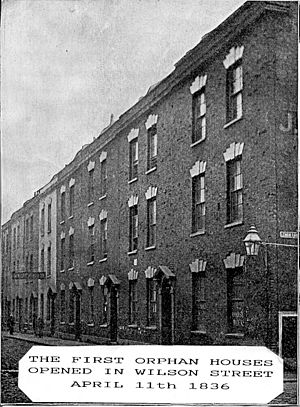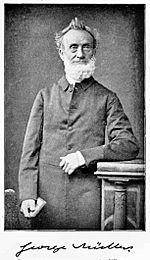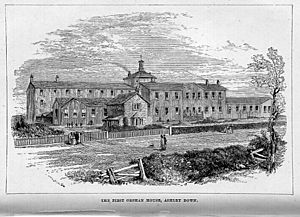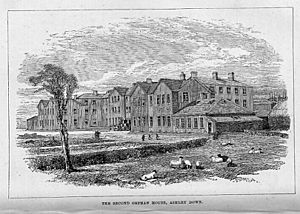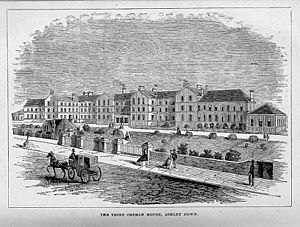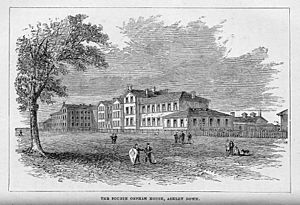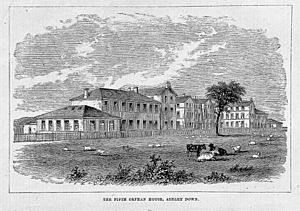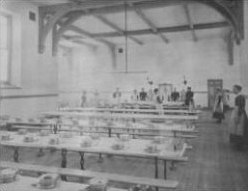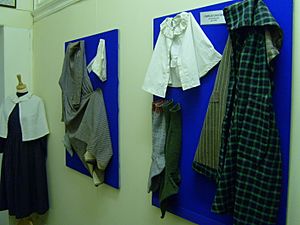New Orphan Houses, Ashley Down facts for kids
The Muller Homes were a famous group of orphanages in Ashley Down, a part of Bristol, England. They were also known as the New Orphan Houses, Ashley Down. A man named George Müller built them between 1849 and 1870. He wanted to show that God would provide for people who trusted in Him.
These five large houses could hold 2,050 children at one time. About 17,000 children lived there over the years. The buildings were sold to Bristol City Council in 1958.
Contents
- Why the Homes Were Built
- Starting the Orphan Homes
- Moving to Ashley Down
- Growing the Work
- How the Homes Were Funded
- Food and Meals
- Clothing and Uniforms
- Education and Learning
- Daily Life at the Homes
- Leaving the Homes
- Changes Over Time
- Modernizing the Buildings
- The War Years (World War II)
- After the War
- What Happened to the Buildings Now
Why the Homes Were Built
The idea for helping orphans started in 1836 with George Müller and his wife. They prepared their own home at 6 Wilson Street, Bristol, to care for 30 girls.
Back then, there were very few orphanages in England. Only about 3,600 orphans had a place to stay. Many orphans ended up in "homes for foundlings" or workhouses. These places were often like slave labor.
Müller believed that God would provide for the children if he prayed. He wanted to show that trusting in God worked. He also wanted to help children who had lost both parents. He aimed to train girls for jobs in homes and boys for different trades.
Starting the Orphan Homes
Müller decided to open an orphan house in Bristol on November 20, 1835. He wanted to prove that God listened to prayers. He prayed for £40 to get started. By November 23, he received about £50 from unexpected sources.
His main goals were:
- To show God's glory by proving that trusting Him works.
- To help orphans spiritually.
- To help orphans with their daily needs.
He was inspired by a large orphanage in Germany. Müller announced his plans but said he would not ask anyone for money. He would only accept children whose parents had both died.
He prayed for £1,000 and staff. Even before he had all the money, 6 Wilson Street was set up for the orphans. Müller and his wife moved to another house. On April 11, 1836, the first girls moved in. By April 21, 26 children were living there.
Because many babies needed care, a second house at 1 Wilson Street was rented. It opened on November 28, 1836, for infants. A playground was also added. By June 15, 1837, the £1,000 Müller prayed for had arrived. Many items were also donated.
It was time to open a third house for orphaned boys. Müller found a large, cheap house. But the neighbors objected, so he withdrew his offer. On the same day, he received £50 from a poor woman to furnish a house for boys. Müller saw this as a sign from God. A third house at 3 Wilson Street was secured on October 21, 1837. A fourth house, 4 Wilson Street, opened in July 1843.
Moving to Ashley Down
On October 30, 1845, Müller received a letter from neighbors. They politely complained about the noise and problems caused by so many children. Müller prayed about this. He felt God was guiding him to buy land and build a special orphanage.
He needed £10,000 to build a house for 300 children. The first donation for this new project was £1,000, received on December 10, 1845. Müller was not surprised, as he expected God to answer his prayers. Before the month ended, another £1,000 arrived.
Over the next year, more large donations came in, including £2,000 and another £1,000. On January 25, 1847, Müller asked God to provide the rest of the money soon. Within an hour, another £2,000 was given. The building fund reached over £11,000 by May that year.
Müller then prayed for land. He found a 7-acre site in Ashley Down for £200 an acre. The landowner later agreed to sell it for £120 an acre. Three days later, a Christian architect named Thomas Foster offered to design and supervise the building for free.
Müller waited until he had the full £10,000 before starting construction. He received even more money, giving him enough to build. The first stone of the New Orphan House was laid on August 19, 1847. As it neared completion, Müller prayed for furnishings. Soon after, he received a £2,000 cash donation from someone who wanted to remain anonymous.
On June 18, 1849, the 118 orphans from Wilson Street moved into the new building. Müller waited a month to figure out the running costs. Then, 170 new children were admitted.
Growing the Work
About 18 months later, Müller thought about building a second house. He received a £3,000 donation on January 4, 1851. After much prayer, he announced his plan on May 28, 1851. The estimated cost for land and building was £27,000, plus £8,000 for furnishing.
A year later, only £3,530 had been received, but Müller was not discouraged. By the end of the fourth year, the fund had over £23,059.
He originally planned for 700 children. However, he couldn't buy nearby fields at that time. So, he changed plans to build a smaller house for 400 children on his existing land, south of House No. 1. Building started on May 29, 1855. Seven months later, a glazier offered to provide all the glass for 300 large windows for free.
By May 26, 1856, the building fund had almost £29,300. By May 26, 1858, Müller had £35,000. This was enough to build a third house, bringing the total capacity to 1,000 orphans.
Plans for the third orphan house began on February 2, 1858. Many donations came in. On June 20, 1858, an unknown person gave £3,500, with £3,350 for the building fund. In September, 11.5 acres of land were bought across the road for £3,631 15s.
Müller first planned for 300 orphans on this site. But he realized he could house 450 for a little more money. He prayed for the extra funds. On January 4, 1859, he received £7,000, setting aside £4,000 for the building. Two days later, £300 came from an anonymous donor. By May, the fund had over £41,911. Construction began in early July.
House No. 3 was finished and opened on March 12, 1862. It had 94 rooms, including two 90-foot dormitories with 50 beds each. Modern kitchen, laundry, heating, and ventilation systems were installed.
Even before House No. 3 opened, Müller thought about building two more houses for 850 children. This would cost at least £50,000. He also prayed for the increased running costs, from £20,000 to £35,000 yearly.
The first donation for this expansion came on June 6, 1861. By November 3, 1864, the fund had over £27,000. The land Müller wanted for the next two houses was for sale. It cost £7,000, which Müller thought was too much. Also, a water company wanted to use part of the site.
Müller prayed about these problems. The tenant on the land agreed to leave. The owner accepted £5,500 instead of £7,000. The water company said they only needed a small part of the land, if any. Müller waited until he had enough money to start both houses together.
By May 1865, the fund had over £24,635. A year later, Müller had £34,002. Then, they found out the cost would be £8,000 more due to rising labor and material costs. Müller couldn't sign a contract for both houses without the full amount. So, they agreed to sign contracts separately. Work on House No. 4 started on May 7, 1866. The money for House No. 5 was ready by December 31, 1866, and its construction began on January 15, 1867.
By February 1, 1868, all the money to build and furnish both houses had arrived. A company glazed the 700 large windows for free. House No. 4 opened on November 5, 1868, and House No. 5 on January 6, 1870. At this point, about 2,050 children and 112 staff lived at Ashley Down.
The total cost to build all five houses was about £115,000.
How the Homes Were Funded
George Müller never asked anyone for money. He believed God would provide everything through prayer. From 1835 to 1870, he received over £319,000 in money and items to sell. This money supported the orphans and built the houses.
Even though he expected gifts, Müller was careful. In 1853, an old widow anonymously donated £90 from selling her house. Müller interviewed her to make sure she truly wanted to give the money. She insisted it was God's provision. Müller accepted it but kept it aside for seven months, offering to return it. She refused.
Müller never went into debt. By the time he died in 1898, he had received £1,500,000 through prayer. Over 10,000 children had been in his care. He always said God protected the buildings from fire and other dangers. They were never insured by a company, only "committed to the care of our Heavenly Father."
Food and Meals
The meals at Muller Homes were simple but healthy for the time. For breakfast, children usually had oatmeal porridge with milk. This was considered very nutritious.
Dinners changed daily:
- Monday: Boiled beef
- Tuesday: Soup with meat
- Wednesday: Rice-milk with treacle
- Thursday: Boiled leg of mutton
- Friday: Soup again
- Saturday: Bacon
- Sunday: Rice with treacle (so staff could attend church)
Breakfast was at 8 AM, dinner at 1 PM, and tea at 6 PM.
The boys helped grow vegetables in the land around the homes. This saved money and taught them useful skills. A former orphan, writing in 1931, said they were never short of food. He remembered that "Never one meal was missing."
Sometimes, there was no money or food in the houses. Yet, no meal was ever missed. Once, the children gave thanks for breakfast even though there was nothing to eat. As they finished praying, a baker arrived with fresh bread for everyone. This was a special treat, as bread was usually two days old to save money. Other times, money would arrive just in time to buy supplies.
Clothing and Uniforms
The children wore uniforms.
- Older boys: Navy blue Eton jacket, waistcoat, white collar, brown corduroy trousers, and a glazed-peak cap. Each boy had three suits.
- Smaller boys (up to 8-9 years old): Cotton smock, blue serge shorts, and strap shoes for everyday. For special occasions, they wore Norfolk suits with broad Eton collars and the same caps as older boys.
- Boys had to learn to knit their own socks.
- Girls: Long green and blue plaid cloaks in cold weather, shepherd's plaid shawls in warm weather. Summer dresses were dull lilac cotton with a small cape. A straw bonnet with a green and white check ribbon was worn all year. Everyday dresses were navy cotton with white polka dots.
- Girls up to age 14 wore blue-checked gingham pinafores indoors. Older girls wore aprons and became "House Girls."
- Girls made their own clothes as part of their training.
- Babies wore donated baby clothes.
The uniforms stayed the same until 1936. Then, girls started wearing knee-length skirts and different hats.
Education and Learning
Each house had its own school rooms. Müller hired many teachers. Children learned:
- Scripture
- Reading, writing, arithmetic
- English grammar, history, geography
- Swedish drill (physical exercise)
- Singing
Girls were taught sewing. All children learned to knit. Boys had to knit three pairs of socks as part of their leaving outfit. Müller even hired a school inspector to keep standards high.
Many children got apprenticeships or jobs after leaving. Boys left Ashley Down at age 14. Girls of the same age moved from the classroom to a domestic science school for their last three years. They helped with cleaning, cooking, laundry, dressmaking, and other household duties. Some helped in the nursery or infirmary. These girls were paid 6d a week, with 3d saved for them until they left.
In September 1951, the Bristol Education Committee took over teaching the children at Ashley Down.
Daily Life at the Homes
The children had a strict but organized daily routine:
| 06:00 | Wake up, wash, get dressed. Older children helped younger ones. |
| 07:00 | Girls knitted, boys read. |
| 08:00 | Breakfast. |
| 08:30 | Morning service (religious gathering). |
| 09:00 | School started. Some older children helped make beds first. |
| 12:30 | Playtime. |
| 13:00 | Dinner. |
| 14:00 | School continued. |
| 16:00 | Playtime. |
| 17:30 | Evening service. |
| 18:00 | Tea. |
| 18:30 | "Useful work" – girls sewed, boys worked in the garden. |
| 20:00 | Younger children went to bed. |
| 21:00 | Older children went to bed. |
The famous author Charles Dickens once visited the orphanage without warning. He had heard rumors of mistreatment. Müller initially refused him entry because it wasn't a visitor day. But Dickens insisted. He was eventually shown around the homes. Dickens later wrote a very positive report about the orphan houses in his publication "Household Words."
Three special events were celebrated each year:
- Mr. Müller's birthday (September 27): A holiday with cake.
- Christmas: Each house had a large Christmas tree and every child received a present. Staff ran small sweet shops where children could spend 8d on sweets bought at cost.
- Pur Down summer outing: Children walked 1.5 miles in a procession, carrying bags of biscuits and sweets.
Leaving the Homes
Girls usually stayed until they were 17 years old. They were trained for domestic service (working in homes). Müller believed this was best for them. They learned reading, writing, arithmetic, English grammar, geography, history, and all kinds of needlework and household tasks. They made and repaired their own clothes, worked in kitchens, laundries, and more. The goal was for them to become useful members of society.
Boys were usually apprenticed (trained for a trade) between 14 and 15 years old. They could choose their trade, but once chosen, they stuck with it. The orphanage paid for their outfits and any other costs related to their apprenticeship. Boys learned the same school subjects as girls. They also learned to knit their stockings, make their beds, clean shoes, scrub rooms, run errands, and work in the garden.
Müller carefully chose Christian masters for the boys' apprenticeships. He also checked their business and home life to ensure they were suitable.
Some children who were good students were trained as teachers. Many stayed at the Homes or returned later to work there. Some girls also stayed on as nursing assistants, cooks, or office staff.
When children left, they received:
- A complete new outfit.
- A tin trunk.
- Two changes of clothing.
- An umbrella.
- A Bible.
- A copy of George Müller's autobiography.
- Some money (half a crown for boys, accumulated savings for girls).
- Their train ticket.
Changes Over Time
George Müller died on March 10, 1898. His son-in-law, James Wright, had already taken over as director in 1875. After Müller's death, people praised his work, noting that he achieved so much through prayer alone.
On March 14, 1901, the rules for admission changed. From August 1, 1901, children who had lost only one parent could be admitted. This was because more orphanages had opened, and fewer "full" orphans (who had lost both parents) were applying.
After James Wright died in 1905, Fred Bergin became director, followed by his son William in 1912. Alfred Green took over in 1930, Thomas Tilsley in 1940, and John McCready was the final director from 1952.
Modernizing the Buildings
Over the years, improvements were made to the homes:
- 1909: Rainwater tanks were installed in Houses 1 and 2 to avoid carrying water upstairs. Drainage systems were updated. A hot-air laundry was added to House 1.
- 1910: A swimming pool was built in House 5, costing nearly £5,000. A new classroom was completed in House 1.
- 1913-1914: Playgrounds were paved with asphalt, paid for by supporters. Toilets in House 5 were modernized.
The swimming pool closed in late 1914 because the attendant joined the armed forces. It reopened in late 1922.
During 1925-26, electric lighting was installed on the ground floors and in the infirmaries of Houses 4 and 5. Two more hot water systems were added. The fields, used for farming during the war, became playing fields again.
By 1932, the children were reorganized. All boys (except infants) lived in House 4. A new nursery opened in House 3. The children's uniforms were updated. Girls' cloaks and bonnets were replaced with coats and hats. Boys got tunic suits for Sundays and jerseys with shorts for everyday.
In 1935, the buildings were officially renamed "Ashley Down Orphanage."
The War Years (World War II)
By late 1938, House 2 was empty. In spring 1939, the City of Bristol used it for "salvage work" (collecting reusable materials). All children were moved into three houses. By May, House 4 was taken over by the Royal Navy as a training base, HMS Bristol. Girls moved to House 5, and boys to House 3. Over 1,000 windows needed blackout coverings.
By autumn 1940, the government took House 5 for American soldiers. Finding new housing was hard. But after much prayer, 16 Cotham Park was rented for 80 of the youngest children. They moved on November 7, 1940, just before House 5 was needed.
On December 2, a German bomb exploded near House 3, shattering almost 400 windows. No one was hurt. Soldiers from House 5 helped clear glass and cover windows.
On September 27, 1940, Müller's birthday, a dogfight happened over the orphanage. German planes were driven off, and one was shot down nearby, causing no damage to the homes.
In 1941, the orphanage was formally named "Müller's Orphan Homes."
By May 1944, children from 16 Cotham Park could return to House 3. American soldiers were housed in one building, joined by paratroopers in July 1944.
After the War
In August 1945, House 5 was returned to the Trustees. It took time to make it ready for the boys, but the swimming pool was still usable. By May 1946, House 5 was still being fixed up. A holiday home called Hillbury was bought in Minehead, which later housed about ten children.
Müller built the orphanage far from Bristol's center. But by now, the area was fully built up. So, the Homes decided to buy land further away. In 1947-48, they bought a 400-acre estate at Backwell Hill. They planned to convert the existing house and build new orphan houses there. They also decided to admit any needy child, not just full or partial orphans, as numbers were decreasing.
The Backwell estate included two farms with cows, making the orphanage self-sufficient in milk.
By 1950, rising costs made the Backwell plan too expensive. So, they decided to buy smaller houses for about 15 children each in towns within 20 miles. One such house was bought in Weston-super-Mare for younger boys and girls.
On July 7, 1951, 35 younger children moved from Ashley Down to Backwell Hill House. In September, the Bristol Education Committee took over teaching the orphans. More properties were acquired in Weston-super-Mare, Clevedon, and Bristol. These new homes were called "Scattered Homes."
By 1954, the charity's name changed again to "The Müller Homes for Children." Negotiations began to sell the five Ashley Down houses, swimming pool, and playing fields to Bristol Corporation.
In 1955-56, 16 Cotham Park and 7 Cotham Park were bought. These needed much work before the final move from Ashley Down. No. 16 became "Ashley Down House," and No. 7 became "Müller House."
In July 1957, the Backwell estate was sold. The remaining children were moved to the Scattered Homes. In spring 1958, the last children left House 3 at Ashley Down for 16 Cotham Park. The administration staff moved to 7 Cotham Park on June 10, 1958. This ended 109 years of child care at Ashley Down. At least 11,603 full orphans and 5,686 partial orphans had lived there.
What Happened to the Buildings Now
Today, Orphan Houses 4 and 5 are owned by the City of Bristol College. House 3, where Müller lived and died, was turned into private apartments in 2007. House 1 became apartments in 2013 after being empty for years. House 2 was sold for redevelopment in early 2016.
Visitors should know that for student safety, you should not try to enter the college buildings.
Müller House (formerly House 3) and many other houses are now Grade II listed, meaning they are protected historic buildings.
|


